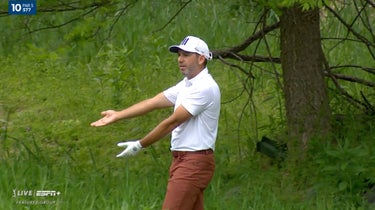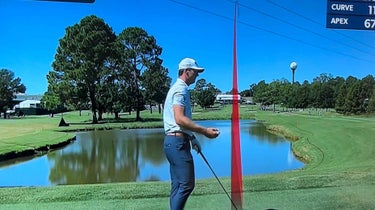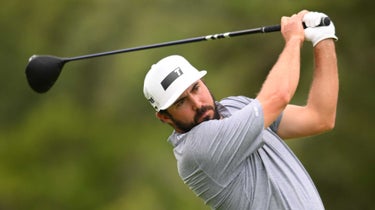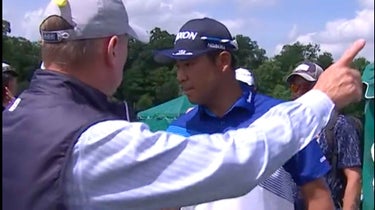2022 was full of bizarre, controversial rulings in professional golf.
GETTY IMAGES
It’s that time of year again.
As we charge head first into the holidays, pro golf is in a pause of sorts, one of the few real breaks on the calendar. That makes it the perfect time to look back on the year that was, and as with every year in pro golf, 2022 was full of weird, controversial and head-scratching moments involving the Rules of Golf.
The rules are one of the few things that connect the average weekend hacker with the PGA Tour’s best, and the game’s elite players sometimes struggle with following, or simply just understanding, the rules as much as we do.
With a new year on the horizon, we’re looking backing at 15 of the biggest, most talked-about rules scenarios in the pro game from the past 12 months. So scroll down to relive them yourself — you might even learn a thing or two.
The 15 weirdest rules blunders, violations and snafus of 2022
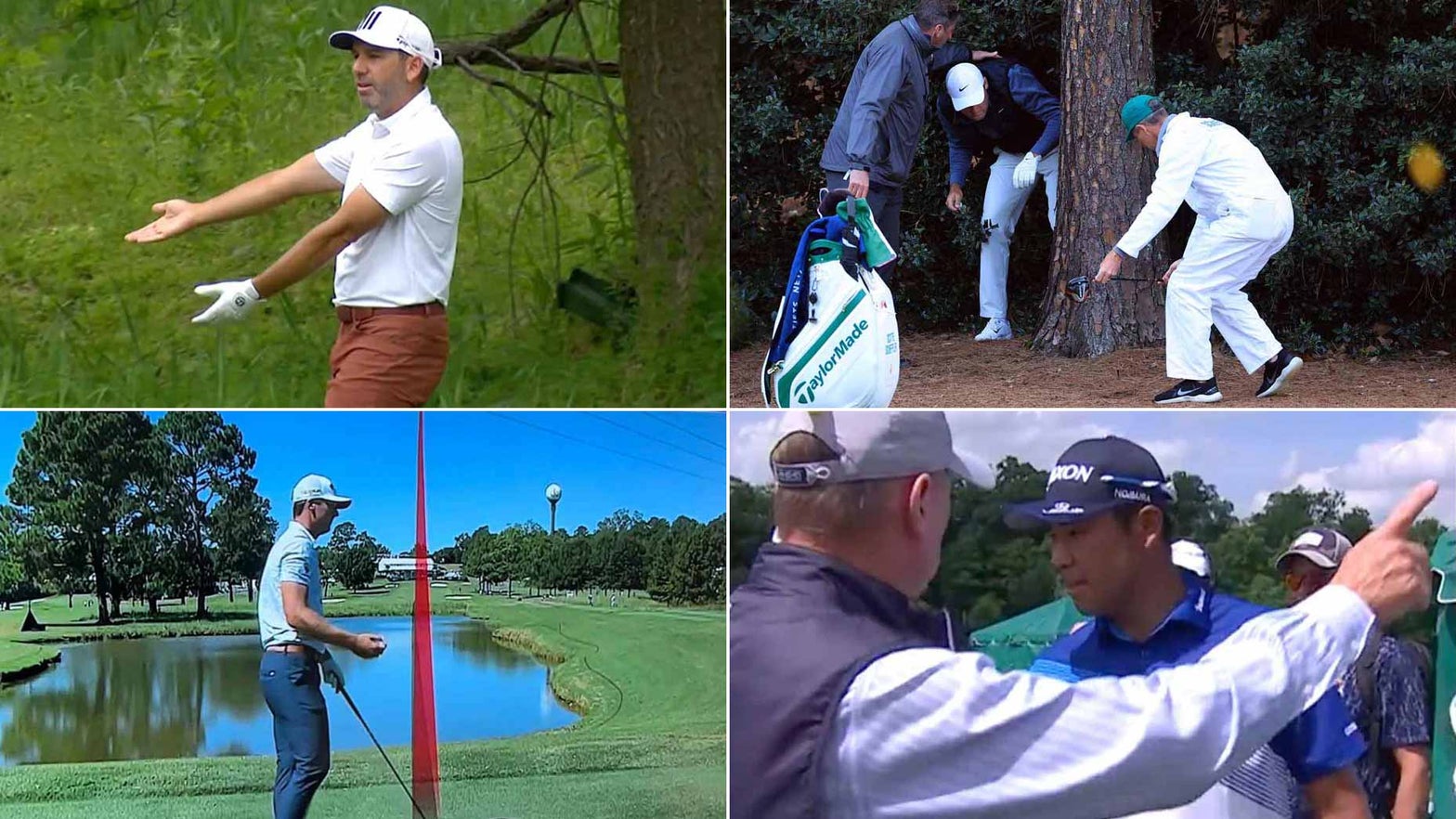
2022 was full of bizarre, controversial rulings in professional golf.
GETTY IMAGES
It’s that time of year again.
As we charge head first into the holidays, pro golf is in a pause of sorts, one of the few real breaks on the calendar. That makes it the perfect time to look back on the year that was, and as with every year in pro golf, 2022 was full of weird, controversial and head-scratching moments involving the Rules of Golf.
The rules are one of the few things that connect the average weekend hacker with the PGA Tour’s best, and the game’s elite players sometimes struggle with following, or simply just understanding, the rules as much as we do.
With a new year on the horizon, we’re looking backing at 15 of the biggest, most talked-about rules scenarios in the pro game from the past 12 months. So scroll down to relive them yourself — you might even learn a thing or two.
1. Garcia threatens to leave Tour over controversial ruling
Sergio Garcia’s biggest move in 2022 was to LIV Golf, but before he left, he was involved in perhaps the PGA Tour’s oddest rules scenario of the year. In the first round of the Wells Fargo Championship in May, Garcia hit his drive on the 10th hole into high grass near a stream beside the hole.
‘Absolute bulls–t’: Sergio Garcia berates official during controversial rulingBY: SEAN ZAK
When he finally found his ball after navigating his way across the stream, a rules official said he had gone over the allotted three minutes for the search and would have to consider his ball lost and take a penalty. What ensued was a fiery debate, and as Garcia walked away in disgust, he said, “I can’t wait to leave this Tour.”
In a final twist later that night, the PGA Tour released a statement saying the rules official was, in fact, wrong and had made an “inadvertent error” while timing Garcia’s search. Garcia’s score, however, would have to stand. One month later, he made good on his promise to “leave this Tour” and joined up with LIV Golf.
2. Varner penalized after fan moves ball OB
In April at the RBC Heritage, Harold Varner III learned an important lesson: Be careful what you wish for.
Playing the par-4 10th hole during the second round, Varner hit his tee shot wide right, close to the out-of-bounds line on the wrong side of the creek. When he reached the area, Varner spotted a ball across the water and asked a fan standing nearby to identify it for him.
The man agreed, picked the ball up and confirmed it was indeed Varner’s, but before relaying the information he placed it back on the ground in a slightly different spot.
“Hit it out of bounds and just — man, I just didn’t really know what to do,” Varner said after the round. “This old man was trying to help, and he ended up picking up my golf ball, and then he almost fell in the creek. Then we’re sitting there, and we’re like, well, the ball’s not exactly where it was.”
It turns out, at least according to Varner, that the man had moved his ball from just in bounds to just out-of-bounds. The fan disagreed. A rules official confirmed it was OB and, despite Varner’s protests, sided with the fan, forcing Varner to take the penalty.
3. LIV Golf’s first rules ‘controversy’
In June, at the first LIV Golf event in England, we experienced the first-ever LIV rules controversy.
While on the tee at the 5th hole, a 169-yard par-3, pro J.C. Ritchie examined the bag of one of his playing partners, Jinichiro Kozuma, curious to see which club he had pulled. As Ritchie leaned over to inspect, Kozuma’s caddie, Yuhei Yoshimoto, signaled to Ritchie the club that his player had pulled, which is a violation of Rule 10.2a of the Rules of Golf, in which players and caddies are prohibited from giving advice to competitors.
LIV Golf’s first rules dispute showed upstart league still a work in progressBY: SEAN ZAK
After a long conversation with rules officials, everyone involved decided there was no violation after all, and that a warning was the appropriate action.
“The boys had a long think about it and they pulled him over and gave [Yoshimoto] a good warning,” Ritchie later clarified. “They decided that, in that case, because I had already seen what club he hit, then [his caddie] signaled, he wasn’t really doing me any favors because I had already got the information I wanted. It was mostly just to get him warned and aware that he can’t do that.”
4. Thomas discovers ‘temporary fence’ isn’t temporary
At the Valspar Championship in March, Justin Thomas had an unfortunate run-in with a fence. On the par-5 1st at Innisbrook, Thomas hit his tee shot right next to an out-of-bounds fence. The fence was not a fixture at the course but was added for the tournament as a boundary marker.
Knowing that players are allowed free relief from temporary immovable obstructions, Thomas asked a rules official to make sure he was in the right. Much to his dismay, he was denied relief. According to the official, the fence, while temporary, was deemed a boundary fence before the tournament, stripping it of “temporary immovable obstruction” status.
So Thomas was forced to hit from the original spot, but not before cracking, “That doesn’t seem to make much sense, does it?” No matter, JT ended up picking up a birdie anyway.
5. Scheffler’s masterful use of rules gets him out of jam
Scottie Scheffler had a momentous year in 2022, and the biggest moment of all was capturing first major win at the Masters. But it almost ended disastrously on the 72nd hole of the tournament.
How clever use of rules helped Scottie Scheffler out of high-stakes Masters jamBY: ALAN BASTABLE
Standing on the 18th tee Sunday with a four-stroke lead, Scheffler badly mishit his tee shot short and into the trees on the right side of the hole.
With a big lead and no hope of hitting his ball from the thick brush, Scheffler took an unplayable lie, and the penalty stroke it demands, so that he could drop it in a more favorable spot. But he wasn’t done yet. After identifying his ideal drop spot in a bed of pine needles within two club-lengths of the ball, Scheffler had a discussion with a rules official, and then began clearing the pine needles away from where he intended to make the drop, while also using a tee to search for roots.
Though he had to convince the official, it turns out Scheffler was well within Rule 15.1/a3, which states, “when a ball is to be dropped or placed, the ball is not being put back in a specific spot and therefore removing loose impediments before dropping or placing a ball is allowed.”
The clever moves gave Scheffler a great line in sight of the green, and he finished off the hole to earn his first green jacket.
6. Pieters earns rare putting do-over
Even in a fun round with friends, rarely is anyone allowed a do-over on a putt they missed. But that’s exactly what happened to Thomas Pieters at the French Open.
On the 3rd hole of the second round, Pieters was taking his putter back to hit a 40-footer when someone in the crowd allegedly coughed. Pieters then tried to stop his stroke, but accidentally made contact with his ball anyway.
As an astute observer of the Rules, specifically Rule 13.1d, Pieters knew that unless there was direct intention to hit the ball, he should be able to replay from the initial spot without penalty.
After consulting with a rules official, it was determined Pieters was correct, and he was permitted to place his ball back in the original spot and take a second crack at the putt without penalty.
7. Bradley stunned by bizarre rules gaffe
In a rarely-called rules violation, Keegan Bradley was stung with a two-shot penalty on Saturday during his second round at the Players Championship.
After he marked his ball on the 16th green at TPC Sawgrass, the ball moved and Bradley played it from where he had marked it, rather than where the ball moved to. As a result, Bradley’s 5 was changed to a double-bogey 7.
Afterward, Bradley said he and his playing partners, Andrew Putnam and Cameron Young, all believed they were in the right at the moment.
‘That was tough news’: Rules gaffe stuns major champion at PlayersBY: NICK PIASTOWSKI
“Well, apparently the rule is — I thought as long as everyone in my group … and I guarantee most of the entire field thought the USGA changed the rule to simplify it — put your coin down, that’s where your ball is,” Bradley said of the moment in question. “So put my coin down, the ball moved, a huge gust of wind came up.”
But according to Rule13.1d (2), Bradley was wrong: “If natural forces cause a player’s ball on the putting green to move, where the player must play from next depends on whether the ball had already been lifted and replaced on its original spot.”
8. Burns powers drive into power lines
Sometimes when you hit a perfect drive down the middle of the fairway, the rules force you to ignore the results and try again. At least that’s what happened to Sam Burns at the Sanderson Farms Championship.
‘That kind of stunk:’ Pro’s tee shot negated because of rarely used ruleBY: NICK PIASTOWSKI
Playing the 9th hole in Round 2, Burns hit a seemingly perfect drive, but then proceeded to slam his club, re-tee it and hit another one. The sequence confused even the TV broadcasters in the booth, who speculated as to why he hit a provisional when his first ball was in the fairway.
What Burns knew that they didn’t at the time was that at the apex of its flight, Burns’ ball clipped a power line.
That required the use of Model Rule E-11, which states: “If it is known or virtually certain that a player’s ball hit a power line (or tower or a wire or pole supporting a power line) during the play of (specify hole number), the stroke does not count. The player must play a ball without penalty from where the previous stroke was made.”
Despite his frustration, Burns knew the rule so well he didn’t even need to ask an official for help. He hit a second, poorer tee shot, but eventually made par on the hole.
9. Hubbard DQ’d for 15 clubs at Houston Open
Pretty much every golfer is familiar with Rule 4.1b: You can’t play with more than 14 clubs. But there are many nuances to that rule, nuances that Mark Hubbard should read up on.
When a Tour pro is hit with a penalty for too many clubs, it’s usually the result of an oversight or mistake. Not so with Hubbard.
Bizarre confusion over 15-club rule leads to DQ of Tour proBY: NICK PIASTOWSKI
Frustrated with how he was hitting his driver at the turn of his second round at the Houston Open, Hubbard decided to add a new one to his bag. He then proceeded to use the new driver on multiple holes, a clear violation of Rule 4.1c. As a result, Hubbard was disqualified after the round.
But why would a pro intentionally make such a huge violation? According to Golf Channel, Hubbard thought he’d only be penalized four stokes, and he was willing to take the hit to get a new driver in play.
10. Sabbatini’s unfortunate DQ helps inspire rule change
Sometimes rules violations seem so unfair that it inspires an official rule change, as was the case with Rory Sabbatini at the 2022 RSM Classic.
Sabbatini had just finished off a solid opening round at Sea Island when he looked at his fairway wood and noticed something wrong. Affixed to the face of the wood were stickers he’d been using on the range to test the club. Unfortunately, he forgot to remove the stickers before his round.
This new equipment rule offers golfers more leniency during roundsBY: RYAN BARATH
Upon informing rules officials of the issue, Sabbatini was disqualified under Rule 4.1 for having a “non-conforming external attachment to the face of a club he used during the round.”
Then in November, the USGA announced it would be tweaking the rule for 2023. Under the updated rule (4.1a(3) golfers are allowed to remove any clubface sticker from the club before using it (with no penalty!) and then continue to use that club during the round. The old rule prohibited the use of the club even after the stickers were removed.
11. Cejka DQ’d (again) for illegal yardage book
This particular rules blunder comes from the PGA Tour Champions. At the Regions Tradition in May, Alex Cejka was disqualified for using a green book that wasn’t approved by the Tour.
Cejka’s mistake was only a violation due to a rule change that was instituted at the beginning of 2022. According to Model Local Rule G-11, “During a round, the player may use only the yardage book(s) approved by the Committee. This restriction also applies to any other maps of the course, including hole-location sheets. Additional restrictions apply to handwritten notes and any other materials used by the player that could help read the line of play on the putting green.”
Believe it or not, this was Cejka’s second DQ involving yardage books. At the 2019 Honda Classic, he was disqualified for using a yardage book that was deemed too big. As with his 2022 violation, Cejka’s DQ at the Honda was due to a rule change that went into effect at the beginning of that year.
12. Hughes misses cut after wrong ball penalty
PGA Tour pro Mackenzie Hughes has every right to be angry at one rules official in particular who may have cost him thousands of dollars.
Bizarre wrong golf ball incident ends up sending Tour pro homeBY: NICK PIASTOWSKI
It all began after Hughes’ second shot on the par-5 9th at Torrey Pines North Course during the Farmers Insurance Open. According to Hughes, he walked up to a flag placed by a marshal that had marked a ball, hit his next shot to within a few feet and marked before his par putt — only to learn that that ball he had hit wasn’t his, and that his real ball was a couple of yards from the one he hit with his third shot.
Despite the fact that the marshal deserves some share of blame, it was a clear violation of Rule 6.3c, and the result was a devastating two-stroke penalty. The blunder had happened on Hughes’ final hole of the second round, causing him to miss the cut by a single stroke.
13. Bryan’s back-up iron earns him four penalty strokes
There’s nothing wrong with testing out an old club or two on the range, just make sure you take those extra clubs out of your bag before hitting the course. In other words, don’t be like Wesley Bryan.
On the 3rd hole of the Monday qualifier for the Sanderson Farms Championship, Bryan pulled out his 7-iron only to notice that it wasn’t his usual 7-iron. Instead, it was one he had been testing in practice. Unfortunately, Bryan had forgotten to remove the club from his bag before the round started, meaning he had played the first two holes with 15 clubs in his bag.
“That’s the wrong 7-iron,” Bryan said after realizing his mistake, throwing back his head and cackling. “You can go ahead and add four to my score, boys.”
The penalty for having too many clubs in your bag is two strokes, unless you don’t realize until mid-round. If that’s the case, as it was for Bryan, the penalty is two strokes for every hole you’ve played with too many clubs.
14. Alana Uriell DQ’d from LPGA Q-school after round
Alana Uriel played in 21 LPGA events in 2022, but because she finished 130th on Tour, she was forced to head to Q-School to earn her card for 2023.
It was a disappointment no doubt, but through two rounds of a December Q-School event in Mobile, Ala., Uriel was sitting in the top 20 and feeling good about her chances to advance. But that’s where the good news ended.
Following her second round, Uriell signed her scorecard only to then notice she had accidentally recorded a par on a hole where she had made bogey. Knowing Rule 3.3b (3), she decided to self-report her error. Because the incorrect score was higher than the correct score, Uriell was disqualified.
15. Matsuyama’s paint job ends in a DQ
Hideki Matsuyama is a former Memorial champion, but his attempt at adding a second title at Muirfield Village in 2022 was thwarted in the middle of his first round when a rules official met him on the course to tell him he had been disqualified.
It turns out Matsuyama had a white white-out like substance on the face of his 3-wood that his club technician had added to help with alignment. Pros sometimes do this with Sharpie marker, and it’s well within the rules. But “a person in the world of golf” had seen Matsuyama’s club and asked rules officials to investigate.
They did, and that meant bad news for Hideki.
Hideki Matsuyama is DQ’d — after ‘person in world of golf’ sees rules infractionBY: NICK PIASTOWSKI , RYAN BARATH
A few holes after alerting Matsuyama to the issue, the officials determined he had violated Rule 4.1a (3), which tournament director Steve Rintoul said is defined as: “A substance or any treatment can’t be applied to the face of a club which could influence the flight of the ball, the spin, the loft or anything on the ball, how the ball performs.”
The result was an unfortunate DQ that even mystified tournament host Jack Nicklaus, who said after the round, “I feel very bad about that. And I don’t — may sound silly, but I don’t understand the ruling because I just don’t enough about it. You know, I’m one of those old-time guys, ancient guys, and we didn’t know any of that stuff.”
What rules tweaks would these major champions like to see? They told us!
We asked some golf greats, including Fred Couples and Gary Player, a simple question: What one rule of golf would you like to amend?
LATEST IN INSTRUCTION

Kevin Cunningham
GOLF.COM EDITORAs managing producer for GOLF.com, Cunningham edits, writes and publishes stories on GOLF.com, and manages the brand’s e-newsletters, which reach more than 1.4 million subscribers each month. A former two-time intern, he also helps keep GOLF.com humming outside the news-breaking stories and service content provided by our reporters and writers, and works with the tech team in the development of new products and innovative ways to deliver an engaging site to our audience.

